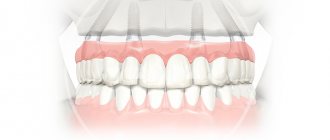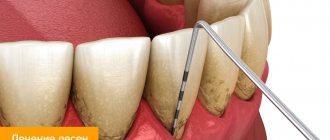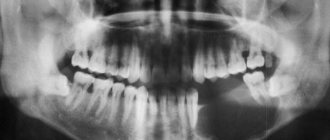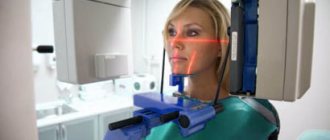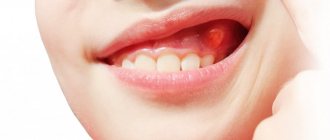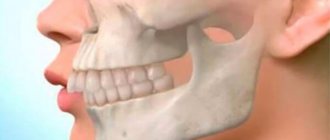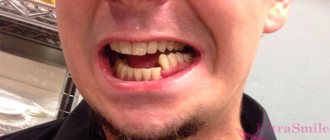Why does gum recession develop?
Recession can be either an independent disease or a symptom that accompanies a certain pathology. It occurs for various reasons:
- Improper hygiene procedures. If you brush your teeth with a hard brush or press hard on it, you can damage the tissue. As a result, inflammation develops and the periodontal structure is disrupted.
- Bad habits. Smoking causes blood vessels to narrow because they are exposed to toxic substances from tobacco smoke. In this case, the blood supply is disrupted, which provokes tissue sagging.
- Bite pathologies, dentition defects. In such cases, the chewing load is distributed unevenly. Therefore, on the one hand, the dental system experiences increased stress, crowns wear off, and gums recede.
- Anatomical imperfections. With a shortened frenulum of the tongue, upper and lower lips, a small vestibule of the oral cavity, short strands of the mucous membrane, as well as in the case of other disorders, recession may occur.
- Incorrect prosthetics. If the gums recede only in the area of the crown, this symptom often indicates an allergic reaction to the materials used to make the dentures, or its incorrect installation.
- Errors when implanting orthodontic structures. If a patient's teeth quickly shift while wearing braces, this causes excessive pressure on the gums, which exposes the roots.
- Age-related changes. People who have reached older ages are more susceptible to the disease.
- Vitamin deficiency, in particular lack of vitamin C.
Regardless of the causative factor, treatment must be started as quickly as possible. Only a doctor can tell you what to do in each specific case.
Causes of recession
The prerequisites that provoke the development of the disease can have a different nature:
- inflammatory process: gingivitis, periodontitis;
- trauma to the gums: improper brushing technique;
- congenital pathologies of the frenulum;
- malocclusion and functional overload of teeth;
- incorrect prosthetics and orthodontic treatment;
- age-related changes occurring in the body;
- lack of vitamins leads to tissue degeneration;
- smoking, which leads to vasoconstriction and disrupts normal blood circulation in the tissues.
Clinical picture during the development of recession
As the disease develops, the gums on the lower teeth recede and those on the upper teeth rise. The roots are gradually exposed. They are not covered with enamel, as a result of which they lack protection. Because of this, tooth sensitivity increases. Visually they look elongated, their color changes at the gums. Interdental gaps form, in which food constantly gets stuck, which brings a lot of inconvenience. In advanced cases, bleeding appears and the gums become inflamed.
The pathology can be localized, that is, affect 1-2 teeth, or generalized, when the entire dentition is involved in the painful process.
What will happen if you do nothing?
If you ignore the problem and do not take any measures to eliminate it, the disease will progress and lead to more serious problems, such as:
- formation of periodontal pockets;
- cervical caries (the most dangerous type of caries);
- tooth mobility.
If you are not satisfied with the aesthetics of your smile or are worried about tooth sensitivity, do not put off visiting the doctor! You can make an appointment with a dentist by calling the numbers below:
+7 or
What is the problem?
Because the part of the tooth that is not covered by enamel is exposed, the risk of developing root caries increases. In this case, it is difficult to cure, since ensuring a high-quality fit of the filling material to the root tissues is very problematic due to their hydrophilicity. Over time, teeth can become loose because there is not enough tissue available to hold them in place.
In addition, gum recession is an aesthetic problem, especially when the disease is advanced. People suffering from the disease develop complexes, which leads to social isolation.
Stages of disease development
As with other dental diseases, it is important to notice and treat gum recession as early as possible. The more advanced the disease, the more difficult it will be to treat. There are several common types of damage to the body:
- Initial stage. Characterized by slight receding gums. It can only be noticed in the place where the gum adjoins the crown. In this case, the disease can be cured easily and quickly.
- Drop by 1-2 mm. It is considered the second stage of prolapse. The influx of tissue occurs from the inside or front side, without affecting the space between the teeth.
- Drop by 3-5 mm. There is a gradual exposure of the dental necks. Bleeding and pain may develop.
- Descent of more than 5 mm. It is considered an advanced form of the disease, which is the most difficult to treat dentally. The roots are greatly exposed, the teeth become very mobile.
It is usually very difficult to notice the first stages of gum recession. Therefore, it is important to come for routine preventive examinations at the dentist. This is the only way to find early manifestations of the disease and effectively eliminate them.
Diagnosis of gum recession
First, the doctor will conduct a visual examination and collect anamnesis. This may be enough for a specialist to make a diagnosis. To confirm it, the following studies are additionally prescribed:
- CT scan;
- inoculation of smears taken from the oral cavity to establish pathogenic microflora;
- clinical tests that are aimed at determining mineral deficiency.
Only after a thorough diagnosis will the dentist recommend how to treat the pathology.
How to treat receding gums
What to do if your gums are receding? First of all, you need to see a dentist. Treatment will become impossible without properly eliminating the cause of the disease.
Among the most common therapy methods are the following:
- Professional oral hygiene. It is important to rid the patient of old plaque, as well as dense deposits.
- Closed curettage. This is a method for cleaning out periodontal pockets that have formed.
- Applied methods of treatment. There are a lot of means - from the use of special biogels to influencing the affected area using microcurrents, lasers, and ultraviolet radiation. Electrophoresis sessions are actively used.
- Drug treatment. The doctor can prescribe antibiotics or recommend the right vitamin complex.
You will also need to maintain proper oral hygiene, brush your teeth regularly, and use special rinses and lotions.
Surgical methods of treatment
Surgery is used only in the most severe and advanced cases. It involves the use of several types of operations:
- Flap restoration. The doctor cuts through the gum tissue and cleans the dental canals. Tissue is transplanted from adjacent teeth.
- Tissue extension. It is important to eliminate the root cause of the disease so that it does not progress further. Treatment involves the application of a special membrane. It acts as a stimulator of the natural regeneration process.
Prevention
To significantly reduce the likelihood of developing dental tissue prolapse, it is worth using simple prevention methods. These include:
- Proper oral hygiene. It consists in regularly brushing your teeth, using mouthwash and dental floss.
- Elimination of diseases that impede blood circulation. In this case, you will need to consult a cardiologist.
- Removing dental plaque. It is very important to remove dense plaque and tartar.
- You should also regularly attend preventative dental appointments. He will be able to quickly identify the first signs of the disease and prescribe the right solution.
What treatment methods are used for receding gums?
Can gums heal on their own? Unfortunately no. But stopping the pathological process is quite possible. Treatment is a rather complex undertaking that requires an integrated approach. In addition, it is not always possible to guarantee a 100% result.
At the initial stages of treatment, it is important to eliminate the cause that caused the gums to recede. In this case, physiotherapeutic procedures, oral hygiene, correction of orthodontic or orthopedic structures, prosthetics, plastic surgery of frenulum, cords, and vestibule of the oral cavity are carried out. If the deviations are caused by a malocclusion, the orthodontist carries out appropriate treatment, which may take several years, but only in this way will the root cause be eliminated.
How to deal with the disease is determined depending on the degree of neglect of the problem. Different techniques can be used:
- Drug therapy. It helps only in the initial stages of the development of the disease. It is aimed at combating concomitant periodontal pathologies, somatic diseases, and helps strengthen the gums and exposed areas of the teeth. Patients are prescribed immunomodulators, anti-inflammatory, hormonal agents, and vitamin complexes.
- Cleaning and polishing of tooth roots. It is carried out in several stages. First, the doctor removes dental plaque above and below the gum, after which he polishes the roots. Thanks to such actions, the gums will be able to “fix” to the surface of the teeth again.
- Gum plastic surgery. The operation is performed using different techniques. The flap method involves cutting the gums. The resulting flap is lifted to gain access to the roots, which are cleaned and polished. The gum is then reattached to the tooth. In some cases, regenerative materials such as membrane, a protein that has the ability to stimulate tissue, are used. When the loss of gum tissue is large, to restore it, the doctor may recommend transplantation (a section of the mucous membrane is taken from the upper palate and transferred to the problem area).
How to lift the gums is determined in each individual case by the doctor, carefully analyzing the clinical picture.
Surgery
In case of severe gum loss, the only effective way to restore it is soft tissue surgery. Today, several surgical techniques are actively used.
| Methodology | Description |
| Flap reconstruction | Gum plastic surgery, when its deficiency is compensated with the help of a donor flap, which is taken from neighboring areas. If the patient’s gums have dropped slightly (by 2-3 mm), this method can be used to quickly restore its previous level. Disadvantages of the technique are traumatic and aesthetic defects (there may be a discrepancy in color between the donor and native areas) |
| Tissue regeneration using plasma lifting and PRF membranes | A more modern technique that does not require taking donor tissue. Injections of plasma and/or installation of fibrin membranes are made into the affected area. This starts the process of tissue regeneration. The treatment is longer compared to the first method, but it is effective and less traumatic |
| Installation of a collagen implant | A minimally invasive technique that is effective for tissue restoration after periodontal disease or age-related gum atrophy. Such implants contain an analogue of connective tissue, which helps restore gums |
| Classic implantation | What to do if the gums have receded, the tooth root is exposed, and the doctor says that tooth extraction is no longer possible? The best solution in this case would be bone grafting and the installation of dental implants. This is the only way to effectively replace lost teeth. In some situations, additional soft tissue plastic surgery may be required. |
In case of mechanical damage, receding gums can be raised using classic surgery with sutures. This is only possible if there are no serious injuries that require additional measures. It is important that surgical treatment is also aimed at eliminating visual defects. To deal with the root cause, comprehensive treatment is required, especially in cases where periodontal diseases develop against the background of problems with the functioning of other body systems.
Gum growth in periodontology. Part 2
The many forms of gum enlargement have different causes. In addition to the types of GO previously discussed in this chapter, gum tissue can be enlarged by increasing the size of the underlying bone and dental tissue. These false enlargements usually do not have any abnormal clinical signs other than a massive increase in the size of the area. For example, overgrowth of underlying bone tissue adjacent to the gum is most often found in tori and exostoses, but it can also occur in Paget's disease, fibrous dysplasia, cherubism, central giant cell granuloma, ameloblastoma, osteoma, and osteosarcoma. Gingival tissue may be normal or have unrelated inflammatory changes. Similarly, during various stages of eruption, especially in the primary dentition, the vestibular gingiva may exhibit a bulbous marginal distortion caused by the superposition of the bulk of the gingiva on the normal projection of enamel in the gingival part of the crown. This increase is called developmental gain, and it often persists until the junctional epithelium migrates from the enamel to the cemento-enamel junction. In general, the development of gingival growths is physiological and they usually do not pose any problems for patients. However, when the overgrowth is complicated by marginal inflammation, the overall picture gives the impression of extensive gingival overgrowth (Fig. below). Neoplastic formations in the gum tissue can be clinically confused with fibrous growths of the gums. Oral cancer accounts for less than 3% of all malignant tumors in the body, but this is not true. It is the 6th most common cancer in men and the 12th most common in women. The gum is not a common site of oral malignancies, accounting for 6% of oral cancers. Epulis is a general term used to clinically refer to all discrete tumors and tumor-like masses of the gingiva. It serves to determine the location of the tumor, but does not describe it. Most lesions designated by this term are inflammatory rather than neoplastic. For example, fibroids arise from the connective tissue of the gums or from the periodontal ligament. These are slow-growing, spherical tumors that tend to be hard and nodular but can be soft and vascular. Fibroids typically develop on a peduncle. Hard gingival fibromas are rare; Most lesions that are diagnosed clinically as fibroids are inflammatory growths. Histopathological examination of fibromas demonstrates bundles of well-formed collagen fibers with scattered fibrocytes and varying degrees of vascularization. The so-called giant cell fibroma contains multinucleated fibroblasts. Alternatively, mineralized tissue (ie, bone, cementum-like material, and dystrophic calcifications) may be found; this type of fibroma is called peripheral ossifying fibroma. Like fibroids, papillomas are benign proliferations of the surface epithelium that are in many cases associated with human papillomavirus (HPV) infection. Gingival papillomas appear as single wart-shaped or cauliflower-shaped bumps (Fig. below). They can be small and discrete, or they can be wide, dense elevations with uneven surfaces. The lesions consist of finger-like projections of stratified squamous epithelium that are often hyperkeratotic, with central cores of fibrovascular connective tissue. Peripheral gingival giant cell granulomas arise interproximally or from the gingival margin. They occur most often on the vestibular surface, and can be sessile or pedunculated. They vary in appearance from smooth, clearly contoured masses to irregularly shaped, with many protrusions and with superficial depressions (Fig. below). Sometimes ulceration of the edges is observed. The lesions are painless, vary in size and may involve several teeth. They can be dense or spongy, and their color ranges from pink to dark red or purple-blue. Clinically, peripheral giant cell granulomas cannot be easily differentiated from other forms of gingival overgrowth. Microscopic examination is required for definitive diagnosis. The word “peripheral” is necessary to distinguish them from similar lesions that arise within the jawbone (eg, central giant cell granulomas). In some cases, gingival giant cell granuloma is locally invasive and causes destruction of the underlying bone (Figure below). Complete removal results in restoration. The lesion has numerous foci of multinucleated giant cells and hemosiderin particles in the connective tissue stroma (see figure below). Areas of chronic inflammation are scattered throughout the lesion, with acute involvement occurring at the surface. The overlying epithelium is usually hyperplastic, with the formation of ulcers at the base. Bone destruction sometimes occurs within the lesion (Figure below). Gingival cysts of microscopic size are common, but they rarely reach clinically significant sizes. When this occurs, they appear as localized enlargements that may involve the marginal and attached gingiva. Cysts occur in the area of the mandibular canines and premolars, most often on the lingual surface. They are painless, but when they grow, they can cause erosion of the surface of the alveolar bone. A gingival cyst must be differentiated from a lateral periodontal cyst, which arises in the alveolar bone adjacent to the root and is developmental in origin. Gingival cysts develop from odontogenic epithelium or from superficial or sulcular epithelium traumatically implanted in the area. Deletion is followed by restoration of the original state. The gingival cyst cavity is lined with thin, flattened epithelium with or without localized areas of thickening. The following types of epithelium are less common: nonkeratinized stratified squamous epithelium, keratinized stratified squamous epithelium, and parakeratinized epithelium with palisade-shaped basal cells. Squamous cell carcinoma is the most common malignant tumor of the gums. It can be exophytic, manifested as irregular growth, or ulcerative, manifested as flat, erosive lesions. It often has no symptoms, remaining undetected until complicated by inflammatory changes that may mask the neoplasm but cause pain; sometimes it becomes obvious after tooth extraction. These masses are locally invasive and involve the underlying bone and periodontal ligament of adjacent teeth and adjacent mucosa (Figure below). Metastases are usually limited to the area above the collarbone; however, more extensive involvement may include the lungs, liver, or bones. Malignant melanoma is a rare oral tumor that tends to occur in the hard palate and maxilla of older adults. It is usually darkly pigmented and is often preceded by localized pigmentation. It can be flat or nodular and is characterized by rapid growth and early metastasis. It arises from melanoblasts in the gum, cheek or palate. Infiltration into the underlying bone and metastasis to the cervical and axillary lymph nodes are quite common. Fibrosarcoma, lymphosarcoma, and reticular cell sarcoma of the gums are rare; only isolated cases have been described in the literature. Kaposi's sarcoma often occurs in the mouth, especially in the palate and gums of patients with acquired immunodeficiency syndrome. Tumor metastasis to the gums occurs infrequently. The low incidence of malignant neoplasms of the oral cavity should not mislead the clinician. Ulcers that do not respond to conventional therapy, as well as all gum tumors and tumor-like lesions, should be biopsied and submitted for microscopic diagnosis. In most clinical cases of GO, the clinical picture is complicated by inflammation, bleeding and swelling, which further creates difficulties in identifying the cause and pathological process. A thorough review of the patient's GO, general and dental history is critical to developing treatment and maintaining results. Since some forms of GO are associated with systemic and severe diseases, this approach is also necessary to ensure patient safety before treatment.
